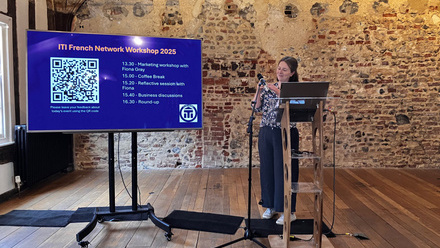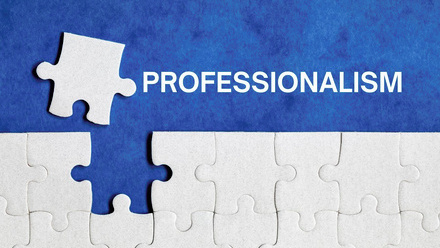Study day
Once a week, Karen Lühning works on developing her wider skills. She tells us how she dedicates Fridays to continuing professional development.
I am sitting in the kitchen with a big mug of coffee, listening to a Japanese audio blog. It's Friday, which for me means that it’s ‘Fortbildungs-Freitag’: my continuing professional development (CPD) day.
I’m a freelance translator, working from English and Japanese into my mother tongue, German. After a number of years as a project manager in the automotive industry, I decided 18 years ago to change tack and set up my translation business.
I learned how to work as a freelancer, acquired some clients, started using CAT tools, acquired some more clients, improved my skills through practice, started having a steady stream of jobs and settled into certain routines. I also moved house and country, got married, had a child, and fitted work around raising a child and everything that went with it. Then, towards the end of last year, it felt as if I had hit a wall. The fun had gone out of things. I needed a bit of a breather and some headspace.
One thing I tried to do was to keep Fridays for myself. However, after a few weeks I’d invariably end up working just like any other weekday. So when it came to making my New Year’s resolutions it seemed pointless to make the same one about ‘free Fridays’ once again; it hadn’t worked in the past and, if nothing had changed, there was very little chance I could make it work now.
I pondered the whole work-life balance conundrum and how to keep things interesting for myself. I talked to my husband, to a fellow translator, to friends and to other freelancers. I also thought about areas of my business that could do with improvement: not just the areas that did not work as efficiently as I would like them to, but also the things that I would like to do more of. And that’s when it hit me; what I needed was a day of learning and studying. I would dedicate Friday to CPD.
Making CPD Friday formal
Like most of us, I had been aware of the recommended 30 hours of CPD per year. And since I am an avid consumer of newspapers, books, magazines and podcasts in my source languages, I always managed to fill those 30 hours with informal studies alone. However, I had never officially logged my hours or taken a more structured approach to learning. It was always one of those topics that I knew I needed to tackle but I put off, feeling that I had too many things to juggle already and not enough time to take this on too.
Once I had established that Friday was going to be my day of learning, I had to tackle the pleasurable task of filling the day with things I wanted to learn.
Nowadays, there is a lot of talk about goal setting – performance goals, exercise goals, study goals, the list goes on. However, other than wanting to meet the CPD goal of 30 hours per year and to do something CPD-related every Friday, I didn’t start out with any specific goals about where I wanted to be at the end of my first year of CPD Fridays.
This, admittedly, is a personal choice – since I like things to be open and flexible without too many rules and restrictions, I figured this would keep Fridays interesting, fun and inspiring for me. Clearer goals, I knew, might take shape during the course of the year, but at the start I just wanted to take on a wide-ranging array of topics and see where it led me. I did have a few definite priorities: improving my Japanese further, especially my kanji knowledge and my listening skills; finding a better system for terminology management; streamlining my invoicing process and finance management; and improving my planning process.
Making it happen
It was easy to find resources for Japanese study. My shelves are still filled with all kinds of Japanese textbooks from when I studied Japanese at university. I also enjoy listening to the audio blog of JapanesePod101.com (a Japanese language-learning site for which I pay $4 a month on their basic plan), and YouTube has plenty of Japanese videos to improve listening skills (listening to TED talks in Japanese is one of my favourites).
When it came to the other topics, my first port of call was the ITI website. I looked for upcoming webinars (and signed up for two). I also realised that, as a member, it was possible to listen to recorded webinars that have been held in the past in the Webinar library.
One of my large agency clients regularly holds free webinars, too. These are often to do with its software but occasionally also deal with more general topics concerning translation and freelance business. Finally, I found that the online learning platform Skillshare, which I joined a while back mainly because of other interests, offers courses on productivity and on how to run a freelance business, although these are usually more targeted towards freelancers in the art and design field (you can take advantage of the offer of a trial month to see if this would be of interest to you).
Other items on my mental to-do list were a trip or two to the library to research relevant books, and trawling through all the technology newsletters by Jost Zetsche that I keep saving for that day when I have time to give them my proper attention. So even without too much expenditure, there is plenty to keep me going for quite some time.
Progress report
So, how has it gone? One of the huge things is that I’m enjoying myself. I look forward to my CPD Fridays every week. To me, it feels like a bit of a treat to sit down and do nothing but learn for a day. I do sometimes struggle to stop translation work encroaching on my Fridays, but by and large, I have managed the balance fairly well.
And what have I learned? First and foremost, I have noticed that reading up on topics and taking part in webinars or online training has made me think more about how I work and how I run my business. Having earned my living doing translation for almost 18 years, it’s not as if my business were failing.
However, when you are coping with tight deadlines and big workloads, it is sometimes difficult to see where improvements might be possible – or to remember that these improvements do not have to be enormous to make a significant difference. A number of small improvements will still add up, much like the ‘marginal gains’ that some professional cycling teams have used so successfully to their advantage.
For instance, I have tweaked the way I keep track of my completed work and how I file project-related emails. These are very small changes but they have smoothed out my processes. Similarly, I found Richard Lackey’s webinar ‘Tech tools for low- stress linguists’ very useful. Since most freelance translators work on their own, it was great to get an insight into how a colleague works and what tools he uses.
I have immediately made my own version of Richard’s productivity tracker to improve my planning when it comes to working on larger projects, helping me avoid procrastination at the beginning of a project and giving me a good idea of how long I will realistically need to complete the assignment. His tips regarding terminology research and shortcuts also sounded very useful and are currently on my list of things that I must also try out.
I guess this is a difficult topic for most freelancers; we have to make ends meet, so it is always tempting to take on one more job. I can’t say I’ve found the solution to this dilemma, but just being aware of it, and having the Friday to look at what I do and how I do it, seems to have made my work life feel a little more structured and a little less overwhelming.
I can genuinely recommend regularly making time for CPD. It doesn’t have to be Fridays; it doesn’t have to be a whole day every week; but just having the time for new input, which will invariably lead to reflection and then (hopefully) changes and improvement, has proved invaluable to me.
Here in Germany, most towns have something called ‘Volkshochschule’, meaning ‘the people’s university’, with wide-ranging courses from Chinese to aikido, printmaking to cooking with herbs. A few years back, the local branch’s motto was ‘One never ceases to learn. Isn’t that great?’ I wholeheartedly agree.
This article first appeared in the July-August 2019 edition of the ITI Bulletin.
About the writer

Karen Lühning is a freelance translator, working from English and Japanese into German. She specialises in automotive, business and marketing translations. Having lived in France, Japan, Wales and England, she has now settled in Munich, Germany. Outside work, she loves drawing and regularly joins the local Urban Sketchers.






